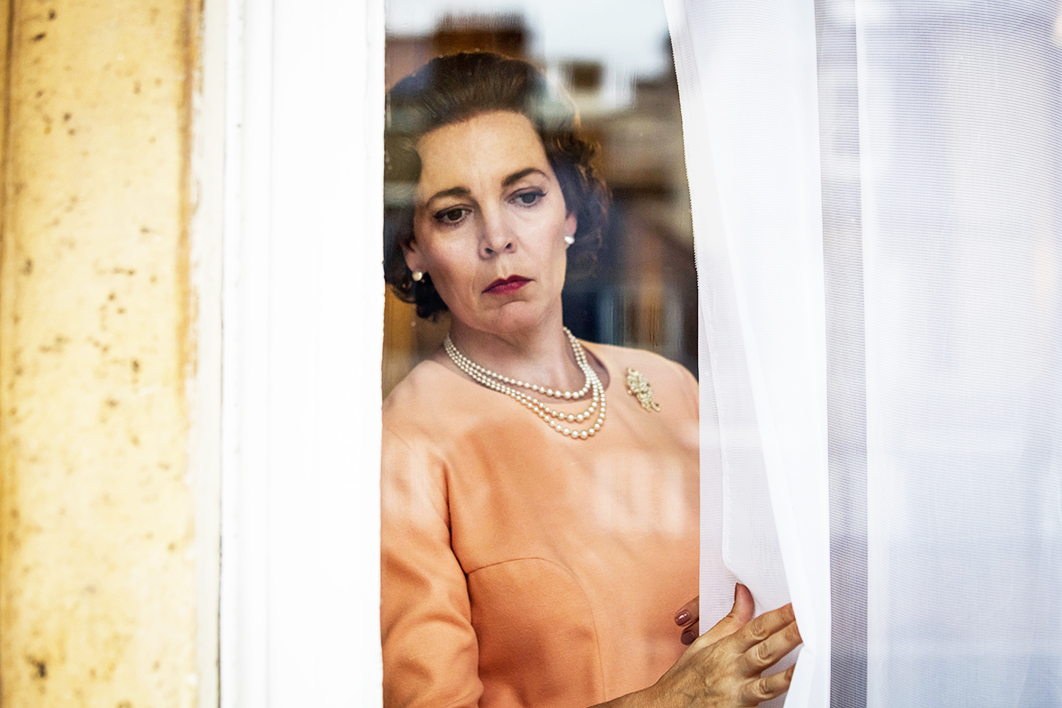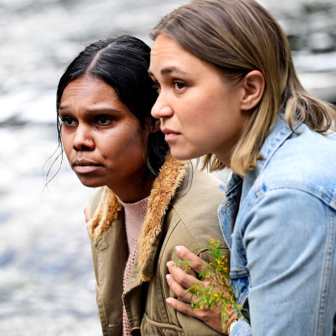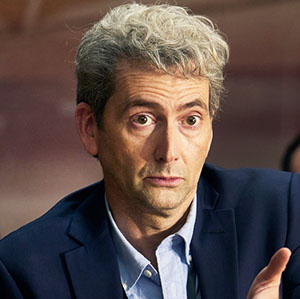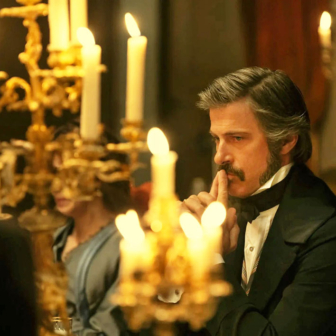“Number three ibble dibble with two dibble ibbles calling number one ibble dibble with no dibble ibbles.” If you’re watching the latest season of The Crown, you will know what this nonsense is about. The royal family is at Balmoral, diverting itself with an after-dinner drinking game that involves the application of a burnt cork mark to your face every time you make a mistake.
The scene is a way of showing how the players, constrained to roles of suffocating formality in public, are capable of having fun off duty in an exceptionally silly way. Though, of course, it is about more than is immediately apparent. Princess Anne, whose outstanding skills as an equestrian are displayed in other scenes, is the best player — quick, agile, astute. The Queen Mother, generally shown in the series to be oblivious to the family’s more troubled affairs, is enjoying it all rather too much and has made so many mistakes her face is covered with cork marks. Prince Charles, averse to all forms of exhibitionism, is otherwise engaged.
Though Charles’s engagements (plural) are central to later episodes, the primary focus of this scene is Margaret Thatcher, “number one ibble dibble,” who picks up on the rules of the game but entirely destroys its spirit. Warned about the mysterious protocols of the “Balmoral test” before her first experience as the Queen’s guest, the newly elected prime minister proceeds to make all the most obvious mistakes, including wearing her tailored blue suit and town shoes on a hunting expedition. She soon loses patience with the time-wasting activities of her hosts.
More seriously, the episode serves to illustrate how Whitehall and the Palace are diverging into parallel universes. This is largely a consequence of Thatcher’s own resolves, founded as they are in a set of notions about Britain that are entirely at odds with the symbolic aspects the Queen must represent. Inevitably, though, the monarchy is becoming anachronistic in more and more ways as the series travels further from the Queen’s postwar accession, when the constancy of the royal presence, and all the ceremony surrounding it, helped to restore national morale.
As season four opens in the late 1970s, tensions are escalating on several fronts. The Queen’s entry to Trooping the Colour is intercut with footage of rioting in Northern Ireland. Against the chaotic desperation exploding in the streets of Belfast, the meticulously orchestrated event at Buckingham Palace, before an adoring crowd, comes across as an offence against political reality.
Manipulative juxtapositions like that one recur in the portrayal of other significant events of the 1980s. Mark Thatcher’s disappearance for six days somewhere in the Sahara during the Paris–Dakar car rally is made to coincide with the start of the Falklands war, which in fact occurred six weeks later. The time-shift means that Thatcher can be shown reacting impatiently to being called away from an intensive conference about the search for her “favourite child” to respond to questions about the security of the troops she is about to send to war.
We are not meant to like Thatcher. Gillian Anderson is slighter than the original, so the big hair looks all the more grotesque, and her stooped posture and forward thrust of the chin sometimes evoke the Wicked Witch of the West. In the episode titled “Fagan,” which focuses on the social impact of growing unemployment, her voice seems to be in the background in every scene, issuing edicts from nearby radios and televisions.
This is perhaps the strongest episode. The dramatic structure is cleverly worked out, and the polemical manipulation seems more or less justified. In one especially effective juxtaposition, the camera cuts from a line of smiling guests queueing to meet the Queen at a garden party to people waiting in a dole queue to be quizzed by the battleaxe behind the counter. Fagan is the unemployed painter who notoriously evaded Palace security to find his way to the Queen’s bedroom with the intention of having a word with her about the state of the country. The Queen, in an entirely invented sequence of dialogue, responds to the situation with consummate presence of mind.
We are meant to like the Queen. Olivia Colman captures the over-schooled speech and manner while giving the sense that there is a thoroughly decent human being beneath it all. Others in the family don’t fare so well. When the Queen decides to have lunch with each of her four children in turn, they come across as self-involved, resentful and directionless — except for Andrew, who shows signs of more worrying traits. Prince Charles (Josh O’Connor) seems to have only two moods: glum and glummer. Even when he allows himself to be charmed, he’s so awkward you know the backlash is coming in an outburst of annoyance or a personal attack.
The manipulation of perspectives is at its most concerning in the portrayal of individuals. A simplistic nice woman/nasty woman view of the Queen and Thatcher invites facile, judgemental responses in the viewer. In the case of Charles and Diana, the distortion is more emotionally loaded. Emma Corrin, all sweetness and innocence, has a chocolate box prettiness that is styled to give her an uncanny resemblance to the real-life Princess of Wales in the publicity stills for the series. But the clever replication of the image at iconic moments serves, if anything, to accentuate how this performance is all wrong. Released into motion, the shy smile becomes an excruciating simper, the coyness relentlessly insipid.
It’s not just the actor’s fault — the scenes involving Diana might have been written by Barbara Cartland — but this is an object lesson in how capturing aspects of manner and nuances of speech doesn’t give you the person behind them. Even as a teenager, Diana Spencer exhibited qualities far more distinctive than those of the average pretty teenager. There was a canniness about her, and a sophisticated instinct for managing the public situations in which she found herself. The half-smile was a guarded expression rather than just flirtation; there was a knowingness about the famous wide-eyed look from under the heavy fringe of hair, and, as with all truly glamorous people, there was often an air of austerity about her. The real Diana never simpered.
The Crown is a prime example of the current vogue for series showcasing a new genre of acting, in which techniques of impersonation that were once the speciality of satirists are taken to a level of subtlety and accuracy only possible courtesy of vast archives of video footage. Actors are trained to study behaviour and vocal characteristics minutely, coaches assist with specialised techniques, and costume and make-up artists become key collaborators in achieving the trompe l’oeil effect.
The commercial potential is huge. Olivia Colman as the Queen and Gillian Anderson as Margaret Thatcher (or, as in other recent series, Hugh Grant as Jeremy Thorpe and Jeff Daniels as James Comey): the effect of celebrities playing celebrities, it seems, is to double the fascination. But all this investment in creating the illusion of truth is something of a confidence trick. Dramatisation comes with artistic licence. What is on record from events in the public domain is supplemented by invented renditions of personal conversations, off-the-record meetings and consultations, or what happened when someone was alone in a room.
Observing the accuracies and inaccuracies of The Crown has itself become a journalistic sport. Did Diana really call Uluru “Ayers Dock?” Was the Queen wrongly dressed for Trooping the Colour? Did Michael Fagan have a conversation with the Queen when he broke into her bedroom? Many of those who have found themselves depicted in the events of this latest season, including Fagan, have had their say in the media. Earlier this week, even Four Corners issued a series of tweets itemising the misrepresentation of a 1983 interview with Bob Hawke about Charles and Diana’s Australian tour in February of that year.
Writer/creator Peter Morgan has defended the series, arguing that it should be seen for what it is — television drama, not a documentary, and therefore a work in which creative decision-making takes priority. Certainly he has done a formidable job of forging a compelling dramatic structure from a vast sweep of disparate events. There is some brilliant lateral thinking in the way scenes are composed and sequenced to accentuate key themes or (as in the ibble dibble game) underscore psychological tensions. The cinematography is stunning, especially in the Balmoral episode, and the series makes for addictive viewing. But it also raises ethical concerns that cannot be lightly dismissed.
In a culture obsessed with what is “not okay” in human communication, is it really okay to put words in the mouths of living or recently living people who said nothing of the kind? Surely it is not okay to portray family relationships in a highly pejorative way when those involved, directly or indirectly, will be significantly distressed by what may be downright falsehoods? And if artistic licence is the defence, what is the point of replacing a sophisticated, witty set of comments by Bob Hawke with stereotyped banalities? •




